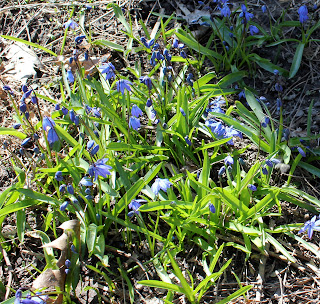I ended up on a nature trail I'd never been on before, so I was glad to have taken the camera. It's good to know there are still places I've never seen within walking distance.
I was happy to see green finally, but surprised that the shy buds didn't curl up into themselves and hide at the sight of me—so timid the little tendrils have been in this Most Reluctant Spring.
Later, I studied the shots at home and realized that they were more tightly themed than I'd first thought. I found that either pairs of photos or in some cases one photo on its own presented two dramatically different interpretations depending upon perspective. It was the distance that time provided that enabled me to change my perspective.
This tree that's growing horizontally over a ravine, for instance: is this its canopy or roots?
This view is beautiful, but dangerous.
Do pine needles prick or are they soft?
Do the same pictures in black and white change the tree's visual texture?
Is this a troll bridge or a dinosaur carcass or scrap lumber nailed onto a tree long ago fallen?
These flowers were rare bursts of colour in a grey ravine—not much when you stood back and looked at the wider landscape.
But look closely. Already a bee, slow-moving and groggy from winter, is hungrily feasting on pollen—up close we can see the miraculous symbiotic relationship that animates the landscape. Up close, we have new information about the mostly brown and grey "dormant" forest. Going in tight, we gain a new perspective. And what of the bee's perspective? Imagine that!
This is what we do in writing, too—see different perspectives, different points of view. It's essential in bringing characters to life, but it can also make writing difficult. My imagination allows me to see each character in many different ways, to hear their side of the story. Is the archetypal Evil Stepmother really evil? Does she have to be? What made her so? Couldn't she be terribly misunderstood? Or maybe she just is what she is, as a willow tree is not an ash, maple, oak or pine. It's a willow.
Or is it? Perspective and imagination can transform this tree.
When I see a willow, especially in Spring, its boughs are draped in jewels. They are ribbons of gold embroidered with green and pink tourmalines. In even the most gentle breeze they sway seductively, sleepily, and I imagine long-haired water nymphs or ondines rising from dark, weedy pools to tempt mortal men into marriage and thereby gain souls.
 |
| Undine by John William Waterhouse. From http://en.wikipedia.org/wiki/Naiad |
 |
| The Rhinemaidens by Arthur Rackham. From http://en.wikipedia.org/wiki/File:DieRheintöchter.jpg |
 |
| Rhinemaidens Warn Seigfried by Alan Rackham. From: http://en.wikipedia.org/wiki/Arthur_Rackham |
I'm very grateful.
Happy Earth Day, sweet planet.















No comments:
Post a Comment